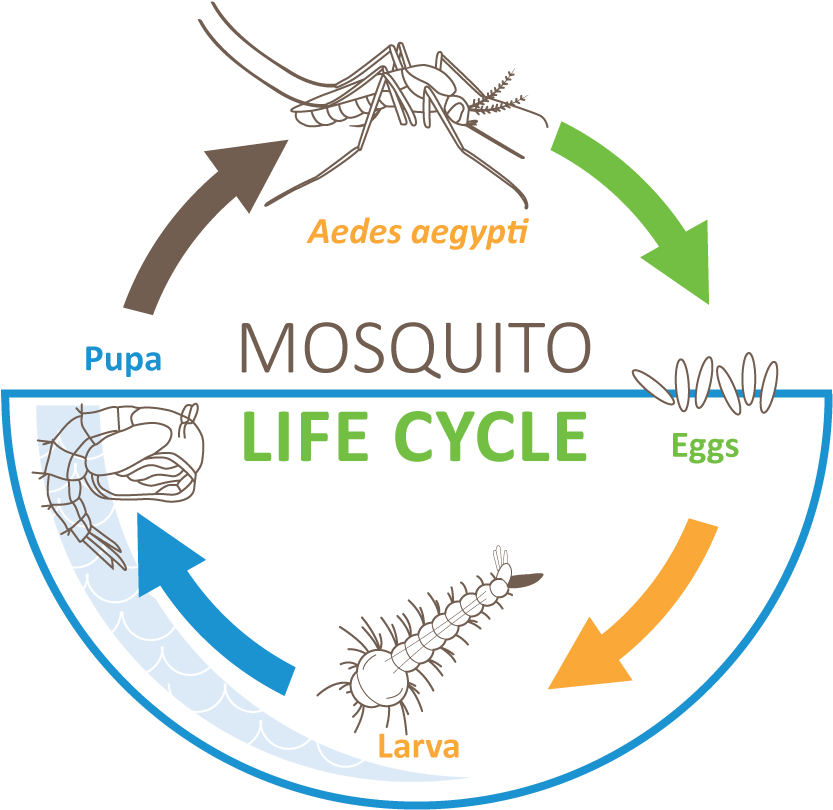In mild climates, mosquitoes are a seasonal nuisance, emerging when temperatures rise. But in the tropics, they are a constant problem. As the climate warms, mosquitoes have more opportunities to breed. Unfortunately, they’re not only annoying, but some carry diseases too (more on that below).
Fortunately, mosquitoes have some predators, like backyard birds, to help keep the population under control.
How else can you keep mosquitoes from biting? Besides knowing (and sometimes avoiding) the different ways you may be attracting mosquitoes, it helps to understand the mosquito’s life cycle and what you can do to keep your backyard from becoming a habitat for these pests.
Life Cycle of a Mosquito
While some experts count the myriad different mosquito species in the thousands (more than 3,000, in fact)1, there is one general characteristic that binds them: all mosquitoes need standing water to reproduce. Some mosquitoes breed in temporary water habitats and are known as “floodwater” species, while others prefer more permanent breeding grounds and are thus considered “permanent water” mosquitoes. Regardless of where the female mosquito chooses to lay her eggs, every mosquito must undergo the same four-stage life cycle: egg, larva, pupa and, finally, adult.2

Stage 1: Egg
To begin the cycle, female mosquitoes lay their eggs either directly on the surface of still water or along its edges (this could include artificial containers, manufactured structures, natural pools and ponds). Mosquitoes may also be found in other areas that are prone to flooding from rain or irrigation. Interestingly, in order for larvae to begin emerging from eggs, the water level of their aquatic habitat must rise so that the eggs become fully submerged. This means that seasonal rainfall, or accidental human intervention, will trigger the egg’s next stage in the life cycle.
Stage 2: Larva
During this stage of development, larvae of most mosquito species hang suspended from the water surface because they require air to breathe. A tube, called a siphon, extends from the larva’s back to the water’s surface and acts as a breathing mechanism3. In order to survive, mosquito larvae feed on microorganisms in the water. After molting three times, the larva will then become a pupa.
Stage 3: Pupa
While this stage can last anywhere from a day and a half to four days, mosquito pupae do not feed during this leg of their transformative journey. Additionally, pupae must still breathe air at the water’s surface.
Stage 4: Adult
A mosquito pupa will continue to develop until the body of the newly formed adult emerges from the pupal skin (complete with a brand new set of wings) and leaves the water. After adult mosquitoes emerge, male mosquitoes feed on nectar from flowers, and female mosquitoes feed on humans and animals for the protein-rich blood needed to produce eggs. After feeding, female mosquitoes will look for water sources to lay more eggs, and thus, the cycle continues.
Diseases from Mosquitoes
Far more than just a backyard nuisance, mosquitoes have infected more people than any other living organism, leading to over one million deaths a year worldwide. Beyond malaria and yellow fever, two of the most well-known mosquito-borne viruses in the US are the West Nile virus and Zika virus.
West Nile first garnered attention in the US nearly 20 years ago, though it had been plaguing Africa, Europe and Asia for much longer. In contrast, the relatively recent discovery of the Zika virus amassed global recognition in 2015 during an outbreak in Brazil, and in 2016, when the virus appeared in Florida. Both viruses are classified as Flavivirus – a genus transmitted by ticks or mosquitoes.4 Currently, West Nile is known to be spread by 65 species of mosquitoes, whereas Zika is propagated by only two. Fortunately, the Zika epidemic has largely disappeared for now, but concerns that it may return linger.5

Virus Symptoms
In both viruses, the majority of those infected do not show symptoms. Those who do generally have the same ailments: fever, headache, fatigue and body aches. The Zika virus can also cause rashes and bloodshot eyes. The more serious complications from these viruses are vastly different. West Nile has been linked to meningitis and encephalitis, and can cause long-term paralysis. Zika is less of a threat to the general population, but can cause severe birth defects.
Virus Transmission
In addition to spreading through mosquito bites, each of these viruses can be passed from a pregnant mother to her unborn child. Unfortunately, there are no vaccines yet for either of these viruses. The best way to protect you and your family is through mosquito prevention.
The West Nile virus is the most widespread of these two diseases, with infected mosquitoes in every US state.There are still no known local mosquito transmissions of the Zika virus in the US, but travelers to most of South America, Africa, India, Pakistan, and other South Asian countries should be aware of affected areas. The CDC’s list is continually updated and can be viewed here.
EEE Virus
In the past few years, another mosquito-spread virus – Eastern equine encephalitis virus (EEEV) – has caught the attention of the CDC6. You may have heard it referred to as the EEE virus.
The EEE virus, though rare, is found in the eastern and southern US. On average, only seven cases are reported annually. EEEV is most commonly found among freshwater hardwood swamps in the Atlantic and Gulf Coast states as well as the Great Lakes. The mosquito species that carries EEEV primarily feeds on avian hosts, but horses are also susceptible, hence its name. Fortunately, since the virus is seen mostly in swampy areas where humans are more sparsely populated, the infection rate is very low.
While confirmed infections of EEEV number only a handful, the symptoms of the virus are very dangerous. The infection can present itself in two types of illnesses – systemic or encephalitic. Systemic infection symptoms include chills, fever, malaise, joint pain and muscle aches. These will generally clear up in a few days to weeks. Encephalitic infection is more serious and involves the swelling of the brain. A few signs are fever, headache, anorexia, vomiting, convulsions and coma. Approximately one-third of all people with EEEV die from the disease, and many who recover are left with mental and physical disabilities.
Where Do Mosquitoes Live?
Other than outright humidity or balmy tropical climates, mosquitoes actually require very little in order to successfully breed. In fact, when it comes to ideal habitats, standing water is the only real prerequisite here – and we aren’t talking about oceans or massive lakes either. A sludge-filled pond, a pothole in the road, even the top of a metal container that collected last night’s rainwater will suffice. Mosquitoes can be very resourceful, and they aren’t overly particular.

Stagnant Water
Because mosquitoes love stagnant water and are equal-opportunity breeders, it’s important to make sure the outside of your home does not contain any areas that regularly collect or contain stagnant water. What might this look like? Well, a few of the more common areas for female mosquitoes to lay their eggs include birdbaths, gutters and downspouts, playpools (for kids), upturned buckets or planters, and even shallow puddles that may collect in your yard.
Remember, it doesn’t have to be a big area; a small-to-medium-size puddle is plenty for your average female mosquito to lay her eggs. Be sure to do a walk-through of your property every few days, especially after a rainfall, to make sure that no preventable bodies of water are accumulating in your yard or near your home. A best practice is to regularly turn over or store unused planters, pots and watering cans that might harbor mosquito larvae.
If you find yourself surrounded by mosquitoes (even when traveling), be sure to have our natural mosquito products on hand!
- American Mosquito Control Association, “Mosquito Info,” AMCA, accessed September 6, 2022, https://www.mosquito.org/general/custom.asp?page=mosquitoinfo.
- Centers for Disease Control and Prevention, “Life Cycle of Aedes aegypti and Ae. albopictus Mosquitoes,” accessed September 12, 2022, https://www.cdc.gov/mosquitoes/about/life-cycles/aedes.html.
- Jed Dillard, “Floodwater Mosquitoes, a Special Brand of Misery,” August 10, 2012, University of Florida IFAS Extension, https://nwdistrict.ifas.ufl.edu/phag/2012/08/10/floodwater-mosquitoes-a-special-brand-of-misery/.
- Centers for Disease Control and Prevention, “Flaviviridae,” National Center for Emerging and Zoonotic Infectious Diseases, accessed September 12, 2022, https://www.cdc.gov/vhf/virus-families/flaviviridae.html.
- Jon Cohen, “Zika Has All but Disappeared in the Americas. Why?,” Science, August 16, 2017, https://www.science.org/content/article/zika-has-all-disappeared-americas-why.
- “Eastern Equine Encephalitis,” Centers for Disease Control and Prevention, accessed September 15, 2022, www.cdc.gov/easternequineencephalitis/index.htm









Leave a comment
All comments are moderated before being published.
This site is protected by hCaptcha and the hCaptcha Privacy Policy and Terms of Service apply.